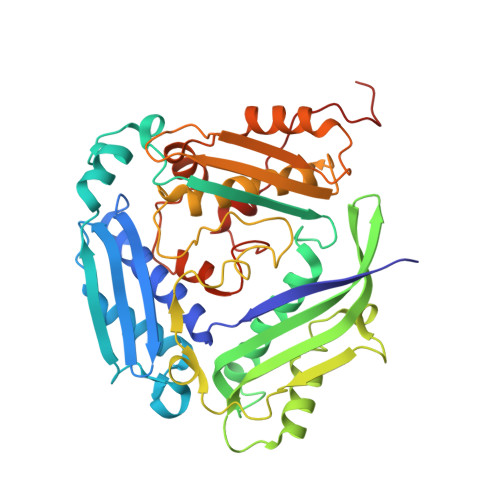S-adenosylmethionine synthases in plants: Structural characterization of type I and II isoenzymes from Arabidopsis thaliana and Medicago truncatula.
Sekula, B., Ruszkowski, M., Dauter, Z.(2020) Int J Biol Macromol 151: 554-565
- PubMed: 32057875
- DOI: https://doi.org/10.1016/j.ijbiomac.2020.02.100
- Primary Citation of Related Structures:
6VCW, 6VCX, 6VCY, 6VCZ, 6VD0, 6VD1, 6VD2 - PubMed Abstract:
S-adenosylmethionine synthases (MATs) are responsible for production of S-adenosylmethionine, the cofactor essential for various methylation reactions, production of polyamines and phytohormone ethylene, etc. Plants have two distinct MAT types (I and II). This work presents the structural analysis of MATs from Arabidopsis thaliana (AtMAT1 and AtMAT2, both type I) and Medicago truncatula (MtMAT3a, type II), which, unlike most MATs from other domains of life, are dimers where three-domain subunits are sandwiched flat with one another. Although MAT types are very similar, their subunits are differently oriented within the dimer. Structural snapshots along the enzymatic reaction reveal the exact conformation of precatalytic methionine in the active site and show a binding niche, characteristic only for plant MATs, that may serve as a lock of the gate loop. Nevertheless, plants, in contrary to mammals, lack the MAT regulatory subunit, and the regulation of plant MAT activity is still puzzling. Our structures open a possibility of an allosteric activity regulation of type I plant MATs by linear compounds, like polyamines, which would tighten the relationship between S-adenosylmethionine and polyamine biosynthesis.
Organizational Affiliation:
Synchrotron Radiation Research Section, Macromolecular Crystallography Laboratory, National Cancer Institute, Argonne, IL, USA. Electronic address: bartosz.sekula@nih.gov.
























